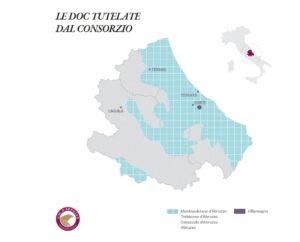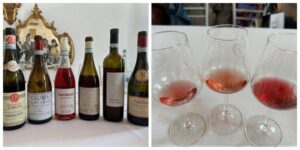
Abruzzo, Italy, is a region that sweeps west of Rome, over the rugged and steep Apennine Mountains that form the country’s backbone, and sloping down to the shores of the Adriatic Sea. It’s debated whether this is a Central or Southern Italian region (see map inset), but that’s beside the point to me. It’s a region unto itself, with some defining wines and wine styles that are a joy to explore.
Abruzzo has four distinct wine provinces: Pescara, Chieti, Teramo, and L’Aquila. The first three have eastern borders on the Adriatic coast, while L’Aquila is situated in the mountainous inland. Soils vary among these four, but generally the mountainous areas have rocky soils, and the lower areas have more clay and sand. The former produces lighter-style wines. All regions, however, benefit from the cooling mountain winds as well as the saline-filled Adriatic breezes. The looming mountains of the massif Gran Sasso (9.5K feet elevation at its highest), and the massif Maiella, both of which have large National Parks, provide the cooling mountain air, and in June 2023 their peaks were still snow covered. Organic wine producer Luigi Valori (see Valori Wines) who in the 1970s was a professional player for Ascoli Soccer, and is a heck of a nice man, bragged that he could go skiing in the local mountains, and within 90 minutes could be drinking wine under the sunny Pescara skies, as depicted in the photo above. Pride for their splendid land was evident among all of the winemakers I encountered in Abruzzo!
The spring and early summer of 2023 were unusually wet in Abruzzo (indeed, most of Italy), which is often hot and dry, with nearly a month and a half of some rain, often torrential, almost every day. Wine growers in the region were very concerned about the current crop in mid-June when I visited, and many expressed concern they would lose a fair amount of vines to mildew as a result of the current situation. However, optimism was in the air, even as we trampled through muddy vineyards and rain sprinkled down on us.
 |
The four wine regions of Abruzzo. Map courtesy of the Consorzio Tutela Vini d’Abruzzo. |
Abruzzo Wines
 |
| Arrostocini! |
The wines of Abruzzo are distinct, albeit quite limited in number of varieties. For red, it’s all about Montepulciano d’Abruzzo, a rich and bold wine that is widely available in the US market, usually at super affordable prices (i.e., under $20 a bottle). It’s a perfect backyard BBQ wine, rich and fruity, that pairs well with grilled meats. In Abruzzo, the typical local pairing is arrostocini, or grilled diced mutton on a skewer (tasty little morels!). The photo, right, was taken at a luncheon at Ciavolich winery.
The US market for exports from Abruzzo is second only to Germany, at approximately 14.2% (Germany is 20%), per the Consorzio Tutela Vini d’Abruzzo, which also supplied the map above. The region also produces white wine, mainly Pecorino and Trebbiano d’Abruzzo. Additionally, pink wines, called Rosatos in Italy, made from the Montepulciano grape and called Cerasuolo, are produced by just about every producer in this region. They are splendid wines, and possibly the future of the region, according to several notable producers.
Cerasuolo d’Abruzzo: From Farmer’s Wine to Everyone’s Wine
The name Cerasuolo is derived from the local dialect for ‘cherry,’ cirasce. It’s apt, as the wines have both a cherry color and a cherry flavor. Cerasuolo wines are generally a dark version of pink wine, however, like Provencal-style rosé wines, they come in many shades of pink or light red, and in many cases look and even drink like a light-bodied red. Cerasuolo wines are made using the native red grape of Abruzzo, Montepulciano (mandatory 85%, the remainder can be other local grapes), and traditionally go through vinification like a white wine. While this ancient technique is common, newer techniques are also in use. For instance, Fausto Albanesi, winemaker/owner at Torre dei Beati, uses three different vinification techniques: the traditional white method for a very pink wine; saignée, aka the bleeding-off method; and cold temperature soaking of 3-5 days. He then blends the wines from each technique for a gorgeous Cersasuolo d’ Abruzzo which he calls ‘Rosa-ae.’ This former engineer produces a Cerasuolo that has beautiful elements of blue flowers and berries, and it’s a joy to drink (as are all of his other wines).
 |
| Cerosulo wines at Abruzzo master class. Notice the dark green bottles, unlike the clear glass used for Provence rosé. Cerasuolo wines come in varying shades of pink and light red. |
Cerasulo has a weight to it, as the Montepulciano grape is thick skinned. This allows the Rosatos to age well beyond the ability of other pink wines, which normally begin to lose their fruitiness within a year of bottling. Not true with Cerasuolo. For instance, the 2020 Cerasuolo d’ Abruzzo Fosso Cancelli from Ciavolich had lovely acid along with framboise, cassis, and tobaccco notes, as well as Mediterranean garrigue from the mountain herbs grown around the 40-year-old vines used to produce this wine. This wine is aged in Tuscan terra cotta vats and sees just a touch of oak, and it’s just splendid.
The Pettinela Tauma is a wine I’ve tasted and sold before at The Wine House (as of this writing it’s not in stock). During a Cerasuolo master class in Abruzzo, our instructor was quite surprised that a US retailer was selling this wine, but I informed him that it usually sits on the shelf longer than most other rosé wines, simply because consumers (and frankly those selling the wine) don’t really understand the wine. “Is it a dark rosé or is it a light-bodied red,” they ask. Now that I know how well these Rosatos can age, I plan to buy them up at the end of rosé season to hold for the next year or two! The 2022 Pettinella Tauma tasted of hay, red fruit, ash, dried porcini mushroom, and also had intense salinity. It’s a complex yet easy-drinking wine, that is sure to create conversation as it activates the senses. The wine is made from grapes out of two vineyards, and the name Tauma is Arameic for ‘twin.’
One of the iconic producers of Abruzzo wines is Emidio Pepe, and his daughter Chiara is now the head winemaker. The wines are biodynamic and extreme care is taken in the vineyard with such things as folding down the growth between vines, rather than cutting it, which helps with water retention (in a normal year, not 2023!). The 2022 Emidio Pepe Cerasuolo has lots of cherry on the palate, plus wild blackberries, and gun flint. The grapes are foot stomped, with 50% going into wood, and 50% going into concrete. Only 5,000 bottles are produced, and in the US market, these hard-to-find wines sell for $50 to $60 a bottle. Another daughter, Stefania Pepe, makes biodynamic 100% organic certified wines at her eponymous winery. She poured me her 2017 Cerasoulo Pepe Rose, which is suitable for vegans and vegetarians, and it again showed the potential for these pink wines to retain their freshness and flavors for several years after bottling.
Tenuta de Melis is a wonderful example of a trend I saw in Abruzzo: younger generations taking over family farming and bringing a fresh, more modern approach to both vines and wines, while respecting the age-old traditions and techniques. The de Melis family has been working their vines and selling their grapes since 1905. Now, father Carmine and children Valeria and Stephen have opened a new artisan winery that currently produces just three wines, among them a Cerasuolo. This wine had a touch of residual sugar, and is fermented on the skins and aged in all stainless steel. Even though Valeria was about to give birth to her first child, when I spoke with her she was full of energy, and totally agreed that Cerasuolo is probably the future of the Abruzzo region. “My grandfather made it,” she said with pride.
Cerasuolo Gets Classified
Beginning in 1967, Cerasuolo Rosatos were classified under the Montepulciano d’Abruzzo appellation, and then in 2010 they received their own appellation, Cerosuolo d’Abruzzo, which is the first DOC to focus on Rosato. “Cerasuolo is the wine of the future of this region,” said Chiara Ciavolich of Cantina Ciavolich. The change in perception of Cerasuolo as a serious wine, not just a farmer’s wine, “can be a booster for the reputation of the region,” she adds. Marina Cvetić of Masciarelli agrees it’s the wine of the future in the region. “It’s the Red Bull of Abruzzo!,” she says with a smile.
Note: As of June 2023, there is discussion in the Cerasuolo d’Abruzzo DOC about changing the rules regarding the color of the wines. Most producers I spoke with were wishing to distinguish their wines from the generally pale pink Provencal style rosé wines. More to come on this topic!
Also, in May it was announced that as of the 2023 harvest, there will be “Superiore” versions of all DOC wines, including Montepulciano d’Abruzzo Superiore, Trebbiano d’Abruzzo Superiore, Cerasuolo d’Abruzzo Superiore, and Pecorino d’Abruzzo Superiore. So, lots happening in this developing wine region of Italy.
Until next time,
Ciao!

